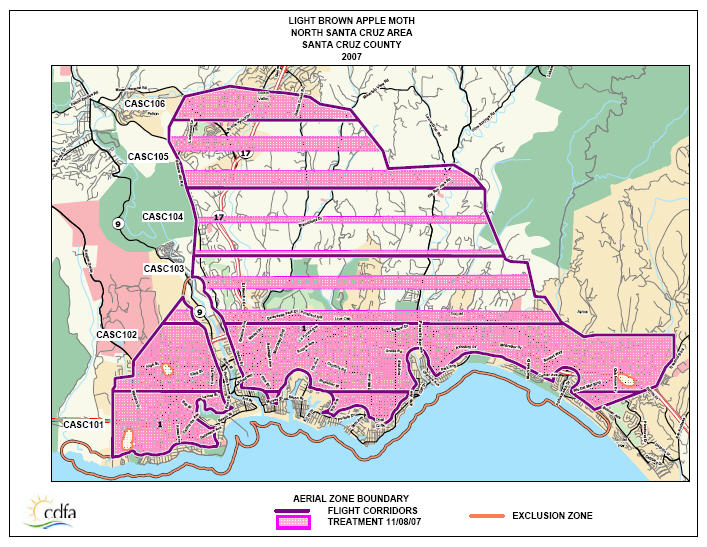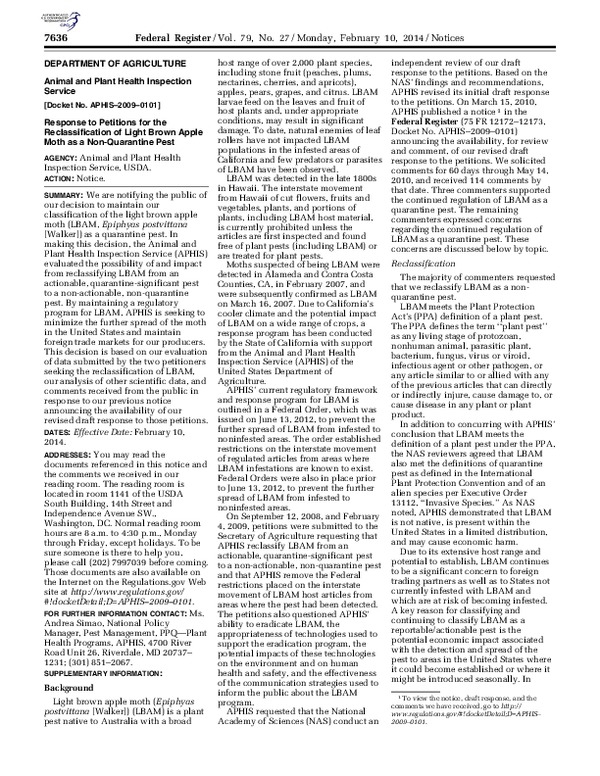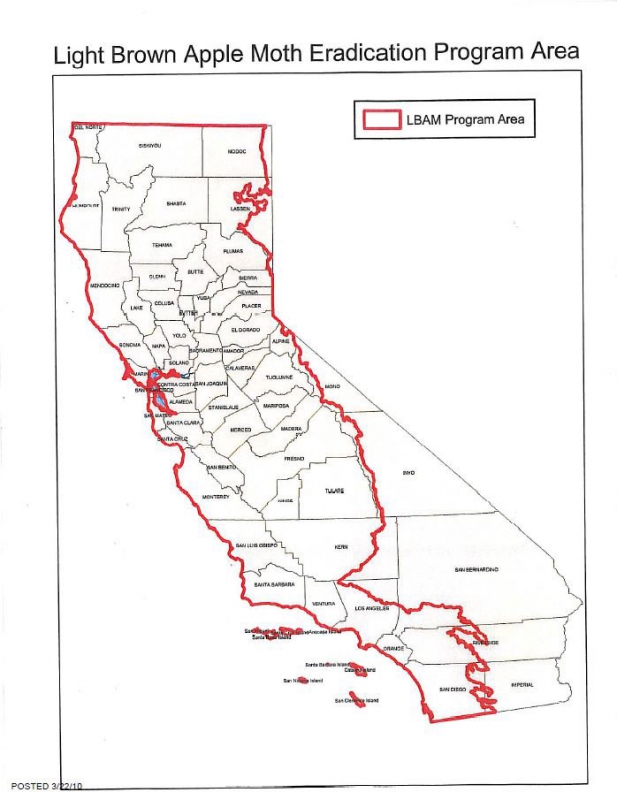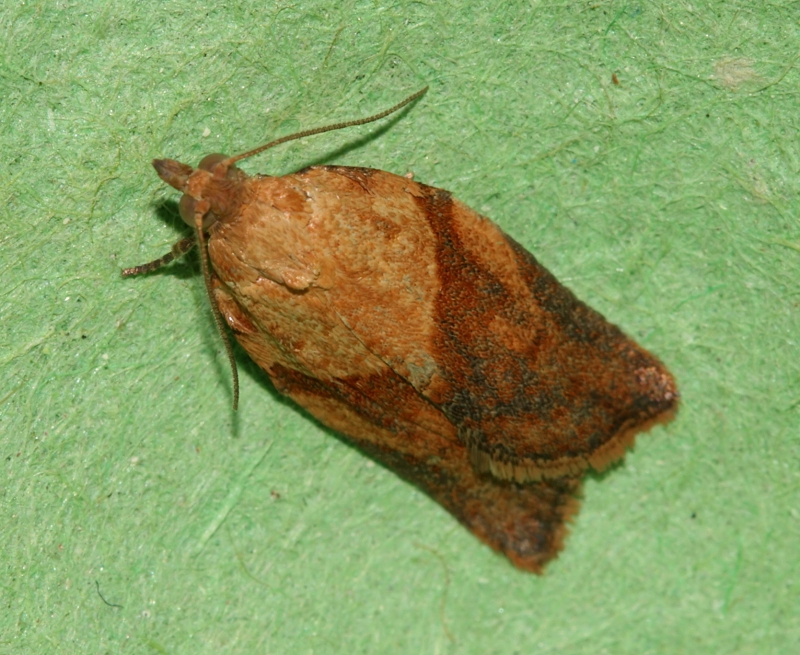From the Open-Publishing Calendar
From the Open-Publishing Newswire
Indybay Feature
USDA Maintains Classification of Light Brown Apple Moth as Actionable Quarantine Pest
The United States Department of Agriculture's Animal and Plant Health Inspection Service (APHIS) announced on February 7 its decision to maintain the classification of the Light Brown Apple Moth (LBAM, Epiphyas postvittana) as a quarantine-significant pest. The APHIS stated that by maintaining this classification it is, "seeking to minimize the further spread of the moth in the United States and maintain foreign trade markets for our producers." The classification and management of the moth as a pest by the government has been of particular concern to those in California, where large residential areas in Monterey and Santa Cruz counties were sprayed aerially with pesticides in an effort to eradicate the LBAM in 2007. [Top photo: CDFA map of the portions of the City of Santa Cruz sprayed with pesticides as part of the state's LBAM eradication program in November of 2007.]

The APHIS claims that if the moth were to be reclassified as a non-actionable pest and APHIS' regulatory program for the LBAM were ended, the related damages to commercial crops would lead to the loss of hundreds of millions of dollars in agricultural industry revenue.
The APHIS had been evaluating the possibility of reclassifying the LBAM as a nonactionable, non-quarantine pest following petitions submitted to the Secretary of Agriculture in 2008 and 2009. The federal agency has acknowledged that the majority of commenters throughout the process, "requested that we reclassify LBAM as a non-quarantine pest."
In a summary of comments from the public, the APHIS states, "the majority of commenters expressed concern regarding the impacts on the environment and human and animal health associated with the use of pesticides and chemicals to control LBAM."
"The commenters expressed concern that chemicals used for the control of LBAM had not been tested on humans and that formulations had not been disclosed," the agency added.
Commenters also expressed a wide range of other concerns.
Some feel the LBAM program is focused on eradication, and they question when exactly the moth was introduced to the state of California. One commenter stated that since the LBAM has been established in the United States for many years, "there is no reason to continue regulating it."
The effectiveness of the chemicals used to eradicate the LBAM was questioned by commenters, with some asking why the program has not taken into account non-chemical methods of controlling the LBAM population.
Some expressed concerns regarding the unfair economic effects the quarantine has had on domestic growers. They claim foreign growers benefit because American growers are required to have LBAM-free fields in order to ship their product between states, while foreign growers are required to have only LBAM-free shipments.
Additionally, several commenters expressed concerns that organic and small family farms are being forced to either use pesticides, which renders them non-organic, or shut down their farms entirely.
Background
In March of 2007, the APHIS claimed it confirmed the LBAM was found in Alameda County and then in Santa Cruz and Monterey, and eight Bay Area counties, including the entire City of San Francisco, and also in Los Angeles area counties.
The decision to spray pesticides was made by the California Department of Food and Agriculture (CDFA), and residents state-wide fought to stop the process.
Over 60 square miles of residential and agricultural space was sprayed over four nights in Monterey county and two nights in Santa Cruz county in the autumn of 2007. The pesticide sprayed contained E. postvittana attractant sex pheromones as its active ingredient, among other substances that were not revealed to the public. Within days, hundreds of people complained they experienced adverse health effects as a result of the spraying.
As the public outcry across California grew, the CDFA announced it would suspended the LBAM eradication effort due to poor weather. After multiple lawsuits were filed in 2008, judges in Monterey and Santa Cruz county then halted any further spraying until an environmental impact report could be completed. Shortly after that, the governor of California announced the spray program would be suspended until tests on the pesticide's toxicity could be conducted.
In 2010, the CDFA released the Environmental Impact Report for its LBAM eradication program, and the possibility of aerially spraying was still included. The newly released document said that the eradication program was planned to last seven years.
In response to the release of the EIR, Stop the Spray East Bay made the following statement in 2010: “Like the rest of the LBAM program, this EIR is not based on science. Peer-reviewed scientific studies released during the past year confirm that LBAM is a minor pest elsewhere, unlikely to spread here as CDFA has predicted, and easily controlled if necessary by low-impact methods in agriculture. The science supports the conclusion that we do not need this expensive, statewide program of chemical and other treatments in residential neighborhoods."
In March of 2010, shortly after the release of the EIR, the CDFA stated in a notice of determination that its objective is to eradicate LBAM from the entire state of California, releasing an eradication program area map that includes the majority of the state and all of its largest cities and most densely populated urban residential areas.
To read the USDA's summary of its decision regarding the petition to reclassify the LBAM as a non-quarantine pest, see the PDF attached below, or go to:
http://www.regulations.gov/#!documentDetail;D=APHIS-2009-0101-0118
For more information about the LBAM spraying in Santa Cruz, see:
https://scruzwiki.org/Light_Brown_Apple_Moth_Spraying
For more general information about the LBAM, see:
http://en.wikipedia.org/wiki/Light_brown_apple_moth_controversy
Alex Darocy
http://alexdarocy.blogspot.com/
The APHIS had been evaluating the possibility of reclassifying the LBAM as a nonactionable, non-quarantine pest following petitions submitted to the Secretary of Agriculture in 2008 and 2009. The federal agency has acknowledged that the majority of commenters throughout the process, "requested that we reclassify LBAM as a non-quarantine pest."
In a summary of comments from the public, the APHIS states, "the majority of commenters expressed concern regarding the impacts on the environment and human and animal health associated with the use of pesticides and chemicals to control LBAM."
"The commenters expressed concern that chemicals used for the control of LBAM had not been tested on humans and that formulations had not been disclosed," the agency added.
Commenters also expressed a wide range of other concerns.
Some feel the LBAM program is focused on eradication, and they question when exactly the moth was introduced to the state of California. One commenter stated that since the LBAM has been established in the United States for many years, "there is no reason to continue regulating it."
The effectiveness of the chemicals used to eradicate the LBAM was questioned by commenters, with some asking why the program has not taken into account non-chemical methods of controlling the LBAM population.
Some expressed concerns regarding the unfair economic effects the quarantine has had on domestic growers. They claim foreign growers benefit because American growers are required to have LBAM-free fields in order to ship their product between states, while foreign growers are required to have only LBAM-free shipments.
Additionally, several commenters expressed concerns that organic and small family farms are being forced to either use pesticides, which renders them non-organic, or shut down their farms entirely.
Background
In March of 2007, the APHIS claimed it confirmed the LBAM was found in Alameda County and then in Santa Cruz and Monterey, and eight Bay Area counties, including the entire City of San Francisco, and also in Los Angeles area counties.
The decision to spray pesticides was made by the California Department of Food and Agriculture (CDFA), and residents state-wide fought to stop the process.
Over 60 square miles of residential and agricultural space was sprayed over four nights in Monterey county and two nights in Santa Cruz county in the autumn of 2007. The pesticide sprayed contained E. postvittana attractant sex pheromones as its active ingredient, among other substances that were not revealed to the public. Within days, hundreds of people complained they experienced adverse health effects as a result of the spraying.
As the public outcry across California grew, the CDFA announced it would suspended the LBAM eradication effort due to poor weather. After multiple lawsuits were filed in 2008, judges in Monterey and Santa Cruz county then halted any further spraying until an environmental impact report could be completed. Shortly after that, the governor of California announced the spray program would be suspended until tests on the pesticide's toxicity could be conducted.
In 2010, the CDFA released the Environmental Impact Report for its LBAM eradication program, and the possibility of aerially spraying was still included. The newly released document said that the eradication program was planned to last seven years.
In response to the release of the EIR, Stop the Spray East Bay made the following statement in 2010: “Like the rest of the LBAM program, this EIR is not based on science. Peer-reviewed scientific studies released during the past year confirm that LBAM is a minor pest elsewhere, unlikely to spread here as CDFA has predicted, and easily controlled if necessary by low-impact methods in agriculture. The science supports the conclusion that we do not need this expensive, statewide program of chemical and other treatments in residential neighborhoods."
In March of 2010, shortly after the release of the EIR, the CDFA stated in a notice of determination that its objective is to eradicate LBAM from the entire state of California, releasing an eradication program area map that includes the majority of the state and all of its largest cities and most densely populated urban residential areas.
To read the USDA's summary of its decision regarding the petition to reclassify the LBAM as a non-quarantine pest, see the PDF attached below, or go to:
http://www.regulations.gov/#!documentDetail;D=APHIS-2009-0101-0118
For more information about the LBAM spraying in Santa Cruz, see:
https://scruzwiki.org/Light_Brown_Apple_Moth_Spraying
For more general information about the LBAM, see:
http://en.wikipedia.org/wiki/Light_brown_apple_moth_controversy
Alex Darocy
http://alexdarocy.blogspot.com/
We are 100% volunteer and depend on your participation to sustain our efforts!
Get Involved
If you'd like to help with maintaining or developing the website, contact us.
Publish
Publish your stories and upcoming events on Indybay.
Topics
More
Search Indybay's Archives
Advanced Search
►
▼
IMC Network





